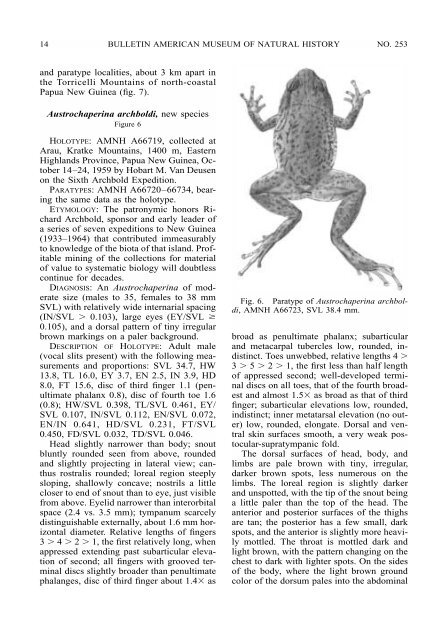SPHENOPHRYNE - American Museum of Natural History
SPHENOPHRYNE - American Museum of Natural History
SPHENOPHRYNE - American Museum of Natural History
You also want an ePaper? Increase the reach of your titles
YUMPU automatically turns print PDFs into web optimized ePapers that Google loves.
14 BULLETIN AMERICAN MUSEUM OF NATURAL HISTORY NO. 253<br />
and paratype localities, about 3 km apart in<br />
the Torricelli Mountains <strong>of</strong> north-coastal<br />
Papua New Guinea (fig. 7).<br />
Austrochaperina archboldi, new species<br />
Figure 6<br />
HOLOTYPE: AMNH A66719, collected at<br />
Arau, Kratke Mountains, 1400 m, Eastern<br />
Highlands Province, Papua New Guinea, October<br />
14–24, 1959 by Hobart M. Van Deusen<br />
on the Sixth Archbold Expedition.<br />
PARATYPES: AMNH A66720–66734, bearing<br />
the same data as the holotype.<br />
ETYMOLOGY: The patronymic honors Richard<br />
Archbold, sponsor and early leader <strong>of</strong><br />
a series <strong>of</strong> seven expeditions to New Guinea<br />
(1933–1964) that contributed immeasurably<br />
to knowledge <strong>of</strong> the biota <strong>of</strong> that island. Pr<strong>of</strong>itable<br />
mining <strong>of</strong> the collections for material<br />
<strong>of</strong> value to systematic biology will doubtless<br />
continue for decades.<br />
DIAGNOSIS: AnAustrochaperina <strong>of</strong> moderate<br />
size (males to 35, females to 38 mm<br />
SVL) with relatively wide internarial spacing<br />
(IN/SVL 0.103), large eyes (EY/SVL <br />
0.105), and a dorsal pattern <strong>of</strong> tiny irregular<br />
brown markings on a paler background.<br />
DESCRIPTION OF HOLOTYPE: Adult male<br />
(vocal slits present) with the following measurements<br />
and proportions: SVL 34.7, HW<br />
13.8, TL 16.0, EY 3.7, EN 2.5, IN 3.9, HD<br />
8.0, FT 15.6, disc <strong>of</strong> third finger 1.1 (penultimate<br />
phalanx 0.8), disc <strong>of</strong> fourth toe 1.6<br />
(0.8); HW/SVL 0.398, TL/SVL 0.461, EY/<br />
SVL 0.107, IN/SVL 0.112, EN/SVL 0.072,<br />
EN/IN 0.641, HD/SVL 0.231, FT/SVL<br />
0.450, FD/SVL 0.032, TD/SVL 0.046.<br />
Head slightly narrower than body; snout<br />
bluntly rounded seen from above, rounded<br />
and slightly projecting in lateral view; canthus<br />
rostralis rounded; loreal region steeply<br />
sloping, shallowly concave; nostrils a little<br />
closer to end <strong>of</strong> snout than to eye, just visible<br />
from above. Eyelid narrower than interorbital<br />
space (2.4 vs. 3.5 mm); tympanum scarcely<br />
distinguishable externally, about 1.6 mm horizontal<br />
diameter. Relative lengths <strong>of</strong> fingers<br />
3 4 2 1, the first relatively long, when<br />
appressed extending past subarticular elevation<br />
<strong>of</strong> second; all fingers with grooved terminal<br />
discs slightly broader than penultimate<br />
phalanges, disc <strong>of</strong> third finger about 1.4 as<br />
Fig. 6. Paratype <strong>of</strong> Austrochaperina archboldi,<br />
AMNH A66723, SVL 38.4 mm.<br />
broad as penultimate phalanx; subarticular<br />
and metacarpal tubercles low, rounded, indistinct.<br />
Toes unwebbed, relative lengths 4 <br />
3 5 2 1, the first less than half length<br />
<strong>of</strong> appressed second; well-developed terminal<br />
discs on all toes, that <strong>of</strong> the fourth broadest<br />
and almost 1.5 as broad as that <strong>of</strong> third<br />
finger; subarticular elevations low, rounded,<br />
indistinct; inner metatarsal elevation (no outer)<br />
low, rounded, elongate. Dorsal and ventral<br />
skin surfaces smooth, a very weak postocular-supratympanic<br />
fold.<br />
The dorsal surfaces <strong>of</strong> head, body, and<br />
limbs are pale brown with tiny, irregular,<br />
darker brown spots, less numerous on the<br />
limbs. The loreal region is slightly darker<br />
and unspotted, with the tip <strong>of</strong> the snout being<br />
a little paler than the top <strong>of</strong> the head. The<br />
anterior and posterior surfaces <strong>of</strong> the thighs<br />
are tan; the posterior has a few small, dark<br />
spots, and the anterior is slightly more heavily<br />
mottled. The throat is mottled dark and<br />
light brown, with the pattern changing on the<br />
chest to dark with lighter spots. On the sides<br />
<strong>of</strong> the body, where the light brown ground<br />
color <strong>of</strong> the dorsum pales into the abdominal
















